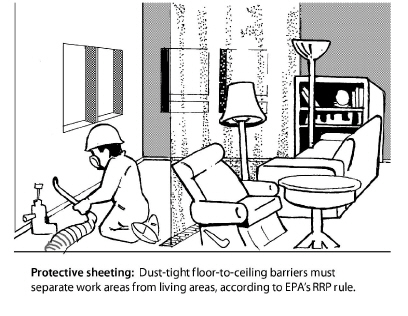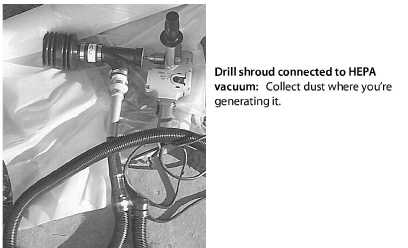
Radon and asbestos are also important hazards to both occupants and workers.
|
SWS Details: 2.0501.1 Radon—Air Sealing Considerations, Basements, and Crawl spaces, 2.0501.2 Pier and Skirting Foundation—Venting, 2.0502.1 Radon Testing and Evaluation |
Radon is a dangerous indoor air pollutant that comes from the ground through rocky soil. The EPA predicts about 20,000 lung cancer deaths per year, caused by radon exposure. Weatherization workers should be aware of: the radon hazard, radon testing procedures, and radon mitigation strategies.
The EPA believes that any building with a radon concentration above 4 pico-Curies per liter (pC/l) of air should be modified to reduce the radon concentration. Health departments and private consultants throughout the U.S. do several common and reliable tests for radon
Weatherization work usually has little effect on radon concentrations. However, ground-moisture barriers and foundation air sealing may reduce radon concentrations in addition to reducing moisture migration and air leakage.
Radon Mitigation
Since radon comes through the soil, mitigation strategies include the following.
1. Installing a plastic ground barrier and carefully sealing the seams and edges.
2. Sealing the walls and floor of the basement or crawl space
3. Ventilating the crawl space or basement with an exhaust fan to dilute radon
4. Depressurizing the ground underneath the basement concrete slab
Weatherization workers may install the first two mitigation strategies as prescribed by the weatherization work order for the purpose of air-sealing.
1.7.2 Asbestos Containing Materials (ACM)
|
SWS Detail: 2.0100.1 Global Worker Safety, 2.0102.1 Insulation Worker Safety, 2.0106.2 Potential Asbestos-Containing Materials |
The EPA classifies asbestos as a “known carcinogen.” The following materials may contain asbestos: boiler and steam-pipe insulation, duct insulation, floor tile, siding, roofing, some types of vermiculite, and some adhesives. Weatherization workers must recognize asbestos and avoid disturbing it. Penalties for mishandling asbestos-containing materials can amount to $25,000 per day.
DOE weatherization policy requires weatherization agencies to observe the following safety precautions regarding asbestos.
• Asbestos siding comes in sheets approximately 16 inches by 24 inches. It is very weatherproof but very brittle. Remove asbestos siding only if you can remove the siding without damaging it.
• Assume that asbestos is present in old gray-colored pipe insulation and duct insulation. Don’t disturb asbestos-containing pipe or duct insulation.
• Caution occupants to avoid disturbing asbestos.
• Don’t cut, drill, scrape, sand or brush ACM.
• Don’t remove vermiculite. Test vermiculite for asbestos, and use air monitoring if asbestos is present in the vermiculite in a building you’re weatherizing.
• Don’t do a blower-door depressurization test in a building where friable asbestos or vermiculite are present. Unless the suspect material has tested negative for asbestos, do a blower-door pressurization test instead to avoid sucking asbestos fibers into the building.
Contract with certified asbestos testers and abatement specialists to mitigate asbestos problems before or during weatherization, if necessary. Mitigate friable asbestos before doing a blower door test.
In 2010, The EPA’s Lead-Safe Renovation, Repair, and Painting (RRP) rule became a legal mandate for weatherization work.
Lead dust is dangerous because it damages the neurological systems of people who ingest it. Lead often poisons children in pre-1978 homes because of paint disturbance during building improvement and because children’s hand-to-mouth behavior is common. Lead poisons workers when they inhale lead dust.
Lead paint was commonly used in homes built before 1978. Contractors working on these older homes should either assume the presence of lead paint or perform tests to rule out its presence.

The RRP rule requires lead-safe containment procedures whenever workers disturb painted surfaces of more than 6 square feet of interior surface per room or more than 20 square feet of exterior surface per side. Cutting, scraping, drilling, or other dust-creating activities disturb lead in pre-1978 homes. Disturbing paint on windows and doors always requires containment.
The RRP requires certifications, warnings, dust-prevention, dust collection, and housecleaning as summarized here.
✓ With pre-1978 homes, either test for lead-based paint or assume that lead-based paint is present.
✓ Every pre-1978 weatherization or renovation job that has been tested and confirmed that lead is present must be supervised by a certified renovator with 8 hours of EPA-approved training when workers disturb more than the minimum paint area or when they disturb paint on windows or doors.
✓ Renovation firms must be registered with the EPA and employ one or more certified renovators.
✓ Signs and barriers must warn occupants and passersby not to enter the work area.
✓ Floor-to-ceiling dust-tight barriers must prevent the spread of dust from the work area.
✓ Plastic sheeting must protect surfaces and fixtures within the work area.
✓ Workers must clean work surfaces sufficiently to pass an EPA-approved dust-wipe test, conducted by the certified renovator.
✓ Workers must not track dust from the work area into the dwelling.


Additional Lead-Safe Work Practices
When engaging in the paint-disturbing activities, follow these lead-safe work practices.
✓ Wear a tight-fitting respirator to protect yourself from breathing dust or other pollutants.
✓ Confine your work within the dwelling to the smallest possible floor area. Seal this area off carefully with floor-to-ceiling barriers made of disposable plastic sheeting, sealed at floor and ceiling with tape.
✓ Don’t use heat guns or power sanders.
✓ Spray water on the painted surfaces to keep dust out of the air during drilling, cutting, or scraping painted surfaces.

✓ Erect an effective dust-containment system outdoors to prevent dust contamination to the soil around the dwelling.
✓ Use a dust-containment system with a HEPA vacuum when drilling holes indoors.
✓ Avoid taking lead dust home on clothing, shoes, or tools. Wear boot covers while in the work area, and remove them to avoid tracking dirt from the work area to other parts of the building. Wear disposable coveralls, or vacuum cloth coveralls with a HEPA vacuum before leaving the work area.
Wash thoroughly before eating, drinking, or quitting for the day.